By: Steve Derderian
sderderian@massgolf.org
“I never realized how many Massachusetts items are here.” From the moment I heard those words, I knew this trip was worth it.
People often ask me what we do in the wintertime when there is no competition locally. For me, this “down time” provides a window to uncover and retell some of the colorful history of golf in Massachusetts. As it turns out, a hefty portion of that history exists within the confines of the nation’s oldest sports museum: The USGA Museum and Library in New Jersey. Founded in 1935, the museum predates the National Baseball Hall of Fame & Museum, which opened a year later.
With last year’s announcement that the USGA will acquire the World Golf Hall of Fame and host it at its new campus in Pinehurst (NC), I wanted to find out more about what is housed in New Jersey. While only “traveling exhibits” will be moved to Pinehurst and other venues on a temporary basis, I wanted to get a look at the museum in its current form and appreciate the valuable exhibits on display for all golf fans to see.
If winter golf isn’t your thing or you want to tack on a destination to your golf trip later this year, consider a pilgrimage to this museum. Through all the photos of fist pumps and trophy waving, there’s so much to learn about the history of this great game.

Upon arrival at headquarters, you walk into the three-story Colonial home that John Russell Pope built in 1919 that has been dedicated specifically to the museum. The USGA purchased the space in 1972, and from 2005 to 2008 more than 20,000 square feet of exhibit space was added as part of the Arnold Palmer Center For Golf History.
The museum has a U-shape structure. Toward the west wing are five exclusive rooms dedicated to some of the game’s legends: Mickey Wright, Arnold Palmer, Bobby Jones, Ben Hogan, and Jack Nicklaus. Inside each are treasures from each as well as interactive videos and sounds from defining moments in their career.
I met with my guide Maggie Lagle, a historian at the USGA Museum, who I’d highly recommend walking through with if you take the tour. Lagle has been with the USGA for almost five years. Simply put, she knows her stuff and was patient as I strolled slowly about the museum.
While everything on display was captivating to me, here are highlights:
The first stop was the exhibit hall where signature items from the past year’s championships are on display. Among them are a pair of signed Sketchers from Matthew Fitzpatrick, this year’s winner of the U.S. Open at The Country Club. What also caught my eye was an Alaskan ulu knife, a crescent shape blade that had an embroidered handle with the 2022 U.S. Senior Women’s Open logo, in honor of the first USGA championship held in the state.

You then enter the Hall of Champions, a well-lit rotunda where all the USGA Championship trophies are permanently stored. On the walls are bronze panels with each one listing the USGA champions of each year since 1895. About a dozen Mass. residents have their names displayed in this room, among the likes of Ouimet, Curtis, Palmer, Sorenstam, Woods, and Lopez, just to name a few.
Earlier this week, the @USGA Museum in Far Hills, New Jersey added a little #MassGolf flare when the names of 2018 U.S. champions Michael Thorbjornsen & Shannon Johnson were added in the Hall of Champions, along with the other USGA Championships from the past year!
🎥: USGA pic.twitter.com/7unKIcXqpZ
— Mass Golf (@PlayMassGolf) January 31, 2019
With well over 750,000 photographs and 100,000 library items, there’s only 5% of it on display currently in the museum, but it sure is an impressive collection. The museum still procures items frequently, including most recently a scrapbook from a fan who attended the 1925 U.S. Open Championship at Worcester Country Club.
The tour through the exhibitions follows chronological order, and immediately when you walk in, there’s a video detailing Francis Ouimet’s triumph at the 1913 U.S. Open at The Country Club in Brookline (one of the USGA’s founding member clubs). The victory earned Ouimet the label as “America’s First Golf Hero” as his working-class background eroded golf’s reputation that the game was only for the elite. In the decade that followed, more than two million Americans took up the game. On display are the scorecards and golf balls used by Ouimet and his playoff opponents Harry Vardon and Ted Ray, as well as Ouimet’s irons and putter.
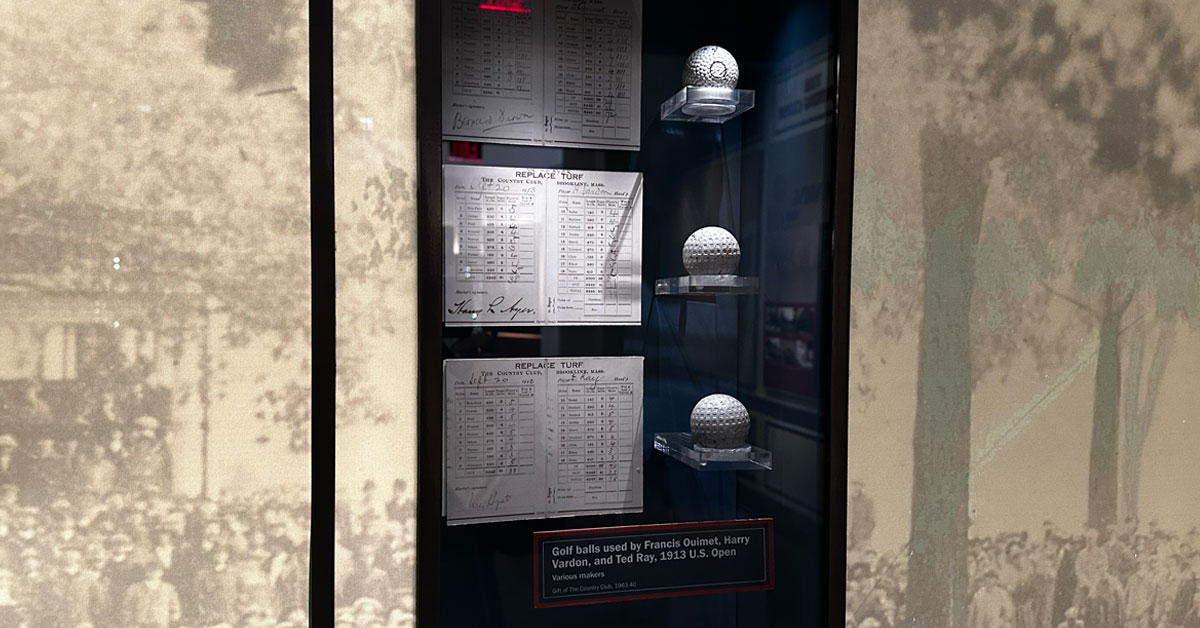
Near the Ouimet display is a fitting tribute to the Curtis sisters – Margaret and Harriot – two of golf’s earliest female champions who are in the Massachusetts Golf Hall of Fame. Inside a case displaying the typical female golf outfit in the early 1900s is Harriot’s straw hat typically worn in competition, which family referred to as her “aunt hat”. Harriot’s brass putter used in her victory at the 1906 U.S. Women’s Amateur at Brae Burn Country Club, and Margaret’s cleek (antique club) used in her 1907 U.S. Women’s Amateur victory at Midlothian CC (IL) also are on display. The original Curtis Cup is also displayed separately. The sisters started the biennial international amateur competition in 1932 “to stimulate friendly rivalry among the women golfers of many lands.”
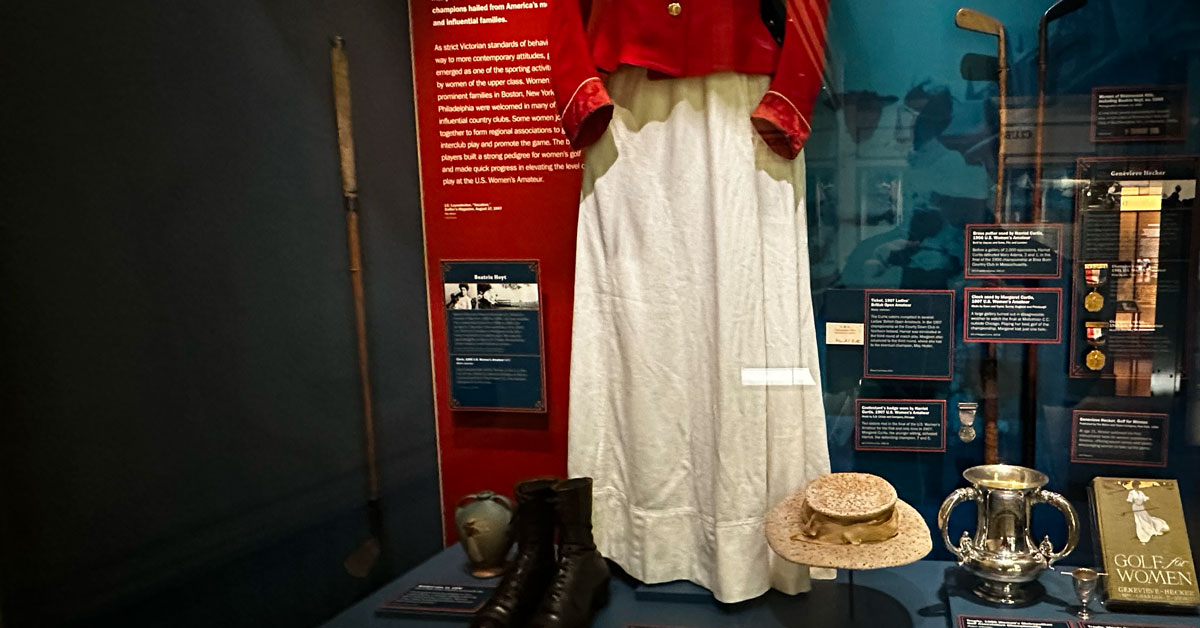
One of the first items received by the museum is perhaps the most famous club in the world. Calamity Jane II, a putter designed by J. Victor East/A.G. Spalding in Chicopee, was used by Bobby Jones for 10 of 13 national championship titles, including the Gland Slam in 1930. Jones used the original Calamity Jane to win his first three, and Spalding produced six replicas thereafter. Jones was known to test out new clubs for Spalding at Longmeadow Country Club, which hosted the 2022 Mass Open.
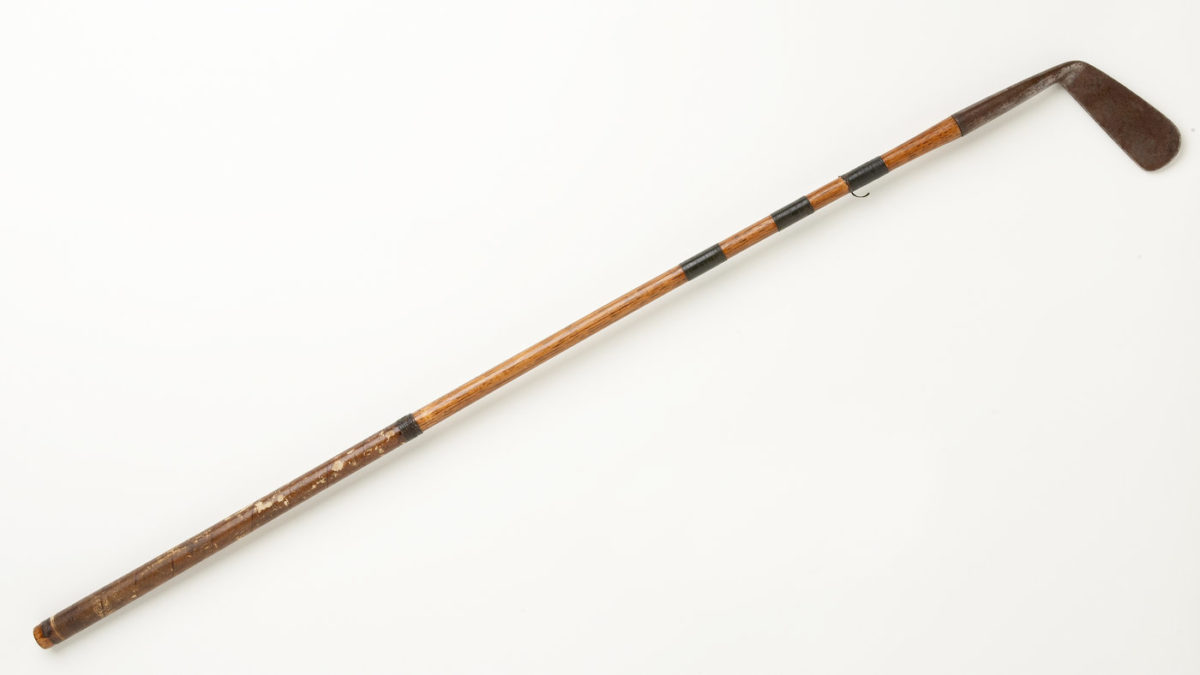
In the next room, I was stricken by the display on William Lawson Little, Jr. the only player to claim consecutive victories in the U.S. and British Amateur Championships (1934, 1935). Little used a Spalding ball to win the 1934 British Amateur but the next year switched to the Titleist golf ball, which debuted that same year, making Little likely the first player to win a major amateur title using a Titleist golf ball, now the most widely played ball on the PGA Tour.
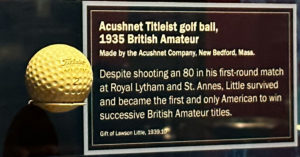
Coming out of the World War II era, there’s a display for Babe Didrikson Zaharias and Ben Hogan under the banner of ‘Heroic Comebacks’. Zaharias was diagnosed with colon cancer in 1953 but in 1954 came back to win the U.S. Women’s Open at Salem Country Club. The display includes signage, tickets, photos and a video reel of her victory and subsequent speech.
You also have clubs used by John F. Kennedy during the 1960s. One sign tells the story of a near ace by Kennedy, who partly joking claimed “If that ball went in, it would have destroyed his political career. In a matter of hours, word would spread that another golfer was aspiring for the White house. Well aware of the public criticism of Eisenhower’s addiction to golf, Kennedy and his advisors tried to keep his own love of the game under wraps.”
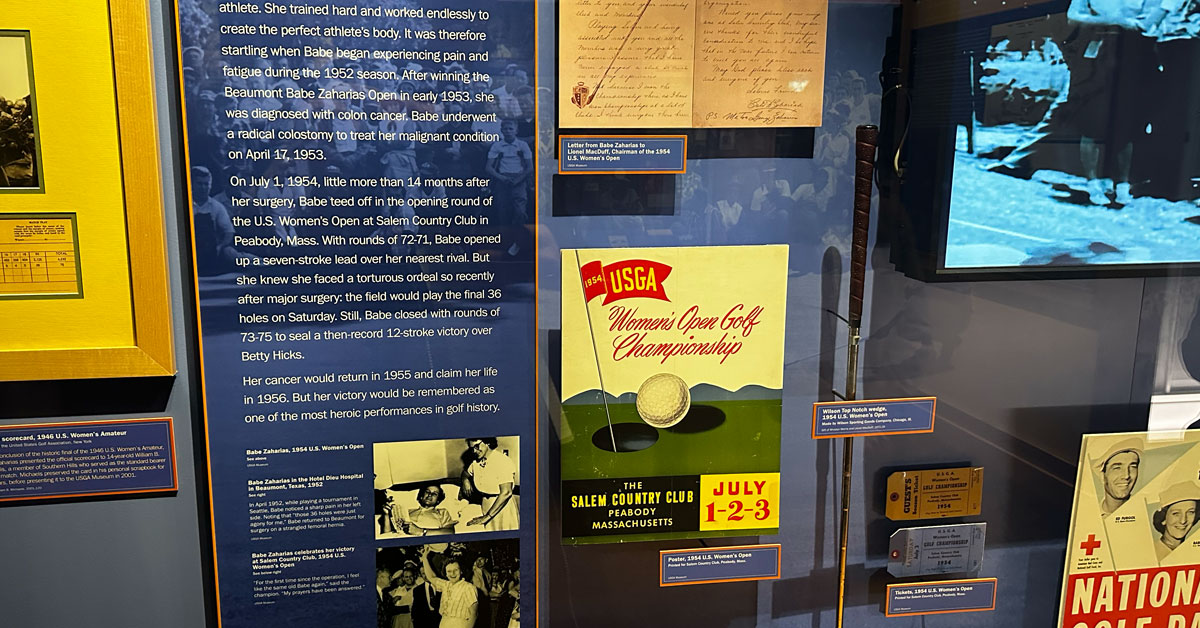
As you progress into the television era, you see tributes to Jack Nicklaus, Nancy Lopez, Arnold Palmer, and New Englander JoAnne Carner, all of whom were dominant forces in the game from the 1960s through the 1990s. In the final room, there’s also a display of Tiger Woods, including the Titleist Vokey wedge he used for the “Tiger Slam” between 2000-01.
Throughout the museum are several winning golf balls and clubs made from Massachusetts companies like Titleist and Spalding, but there were a few items originally made in the Bay State that I didn’t expect.
USGA Player Pins (Robbins Company, Attleboro, 1930s-1950s)
Robbins Co. began as a jewelry manufacturing company in 1892 and later became known for manufacturing badges and medallions. In addition to producing contestant badges for USGA championships, they were well-known producers of badges and metals for the Military, NASA, and the Olympics.
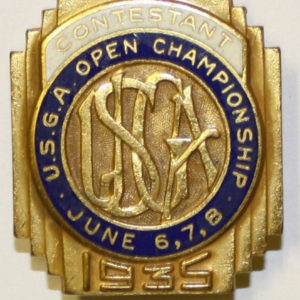

USGA Trophies (North Attleboro, Taunton & Newburyport)
Fun fact: The oldest USGA trophy was made in Massachusetts. The U.S. Senior Open Trophy, aka the Francis D. Ouimet Memorial Trophy, was made by Whiting Manufacturing Company in North Attleboro in 1894, which at the time was one of the most prominent jewelry manufacturers in the nation. It was originally given to the winner of an interclub tournament between The Country Club, Tuxedo Club, Shinnecock Hills Golf Club, and Saint Andrew’s Golf Club. When the U.S. Senior Open was introduced in 1980, The Country Club donated the trophy, which is now named the Francis D. Ouimet Memorial Trophy.
The Mildred Gardiner Prunaret Trophy (U.S. Women’s Mid-Amateur) and U.S. Public Links Championship Trophy also came from Massachusetts. The Prunaret Trophy came from Reed & Barton in Taunton, while Towle Silversmiths in Newburyport designed the U.S. Publinx trophy.
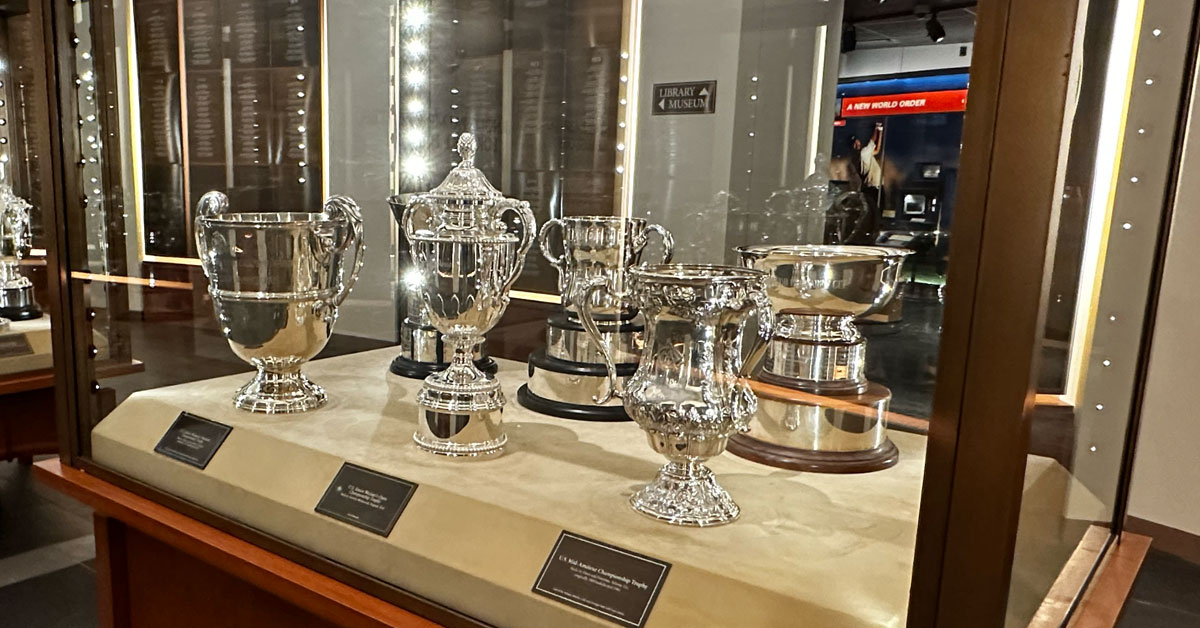
The Moon Club: On February 6, 1971, Alan. B Shepard Jr. brought golf to the Moon. The commander of Apollo 14, tucked away a specially crafted Wilson Staff Dyna-Power 6-iron, adapted from a tool designed to scoop lunar rocks, and two golf balls. Shepard took two swings, exclaiming the second one went “mile and miles and miles.” But the true distance is more complicated than that.
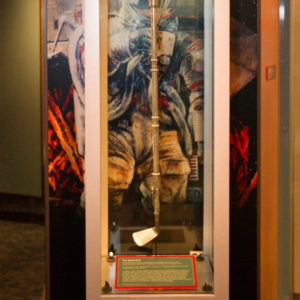
Palmer’s Visor: Perhaps the most famous hat toss in golf history belongs to Arnold Palmer. In 1960, Palmer erased a seven-stroke deficit during the final round at Cherry Hills CC (Colo.) to win his only U.S. Open title. An 11-year-old spectator, Skip Manning, grabbed the visor and got Palmer to sign it. He held it for over 40 years, before deciding to donate it to the museum.
Bullseye Putter: Women’s legend Mickey Wright used her Titleist Bulls Eye putter in 81 of her 82 professional wins, including 13 major championships. The original club was a simple design with a brass head that could putt the ball left or right-handed.
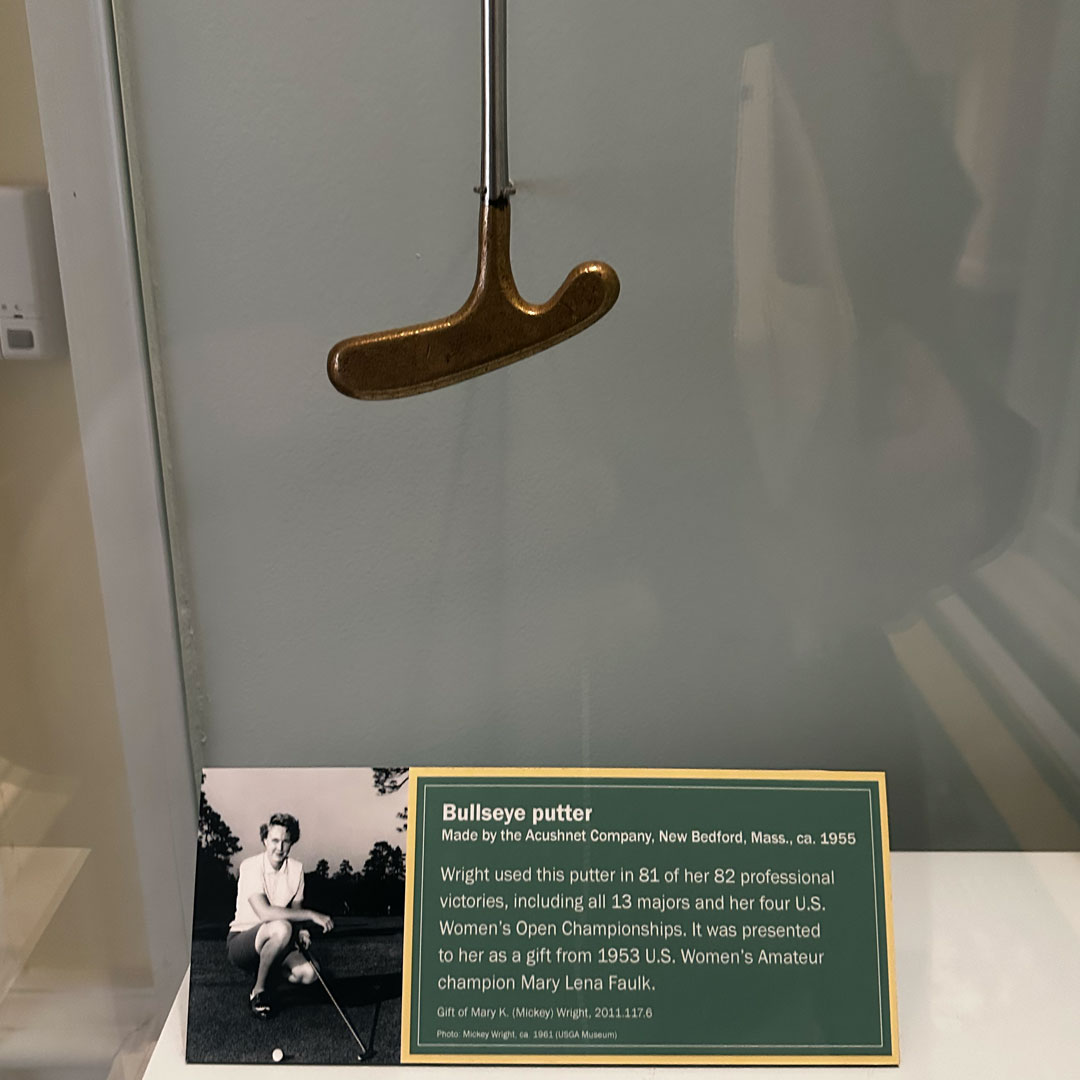
Temporary Rules of Golf: These were issued in 1941 when England faced an intense bombing campaign undertaken by Nazi Germany. One item includes “A player whose stroke is affected by the simultaneous explosion of a bomb may play another ball. Penalty one stroke.” But reading the words below issued by Harry McGrath of Boston, I couldn’t held but think back to temporary Rules put in place during the 2020 COVID-19 pandemic: “Fortunately, rules like these are not now needed in the game of golf. We hope that never again will they be. But, as a keep-sake of history, I thought you would like to have a copy.”
Save for some commuter traffic along the Merritt Parkway in Connecticut, it was mostly smooth sailing to New Jersey and back. The ride is almost entirely highway, and once you reach I-287 in New York and cross the Tapan-Zee Bridge, it’s only an hour to go. Once you get off exit 26 (my favorite number), you see a faded brown sign that reads Golf Museum USGA, with an arrow pointing left. (If you miss it, there’s an easier one to read at the traffic light.) After passing through a residential neighborhood with some of the most gorgeous colonial brick houses I’ve ever seen, you continue straight and on the left you’ll see the entrance to the driveway. Drive to the top and there’s designated spots for guests.

I was originally planning to fit in 9-holes of golf as part of this trip, but ran out of daylight to do so. However, if you make the trip to the USGA Headquarters, there are a few standout places to put the peg in the ground.
1. Van Cortlandt Park – The oldest municipal golf course in the country is located about an hour-drive east in the Bronx. A recent $1.5 million renovation has provided new greens and tee boxes, improved bunkers and better drainage.
2. Neshanic Valley GC – Considered a top-five public golf course in New Jersey, Neshanic features 36-holes on its property designed by Michael Hurdzan and Dana Fry, who are most known for Erin Hills (WI). In addition to its 27-hole championship course, Neshanic also features a 9-hole academy course that measures just 2,019 from the tips with the longest hole being 323 yards.
3. Green Knoll – The first of the Somerset County Park Commission courses, Green Knoll features a rolling layout with some slight elevation changes at times and a good mix of interesting holes. There’s also a pitch and putt course on property that can be enjoyed by players of all abilities.
***Bonus**: From the early spring to late fall, the USGA has the Pynes Putting Course, a 16,000-sq ft. putting green inspired by “The Himalayas” in St. Andrews, Scotland. Putters are provided as well as a souvenir golf ball for guests who want to play the 9-hole course.
506 – Miles Driven Roundtrip
286 – Pictures Taken (including many duplicates…I tried to pick the best ones)
5 – Items Purchased In The Gift Shop
4 – Podcasts Listened To (Including No Laying Up & The Golfers Journal Podcast)
13 – Golf courses passed on the highway
6 a.m. – Departure (Taunton, MA)
9:20 a.m. – Dunkin’ Pit Stop (New Canaan, CT)
10:45 a.m. – Arrival at USGA Headquarters (Liberty, Corner, NJ)
11 a.m. – Tour Of USGA Museum
1:30 p.m. – Library Research (Special thanks to librarian Stacy Schiff for her assistance with this process)
4 p.m. – Departure from USGA Headquarters
5 p.m. – Dinner Stop At Wawa (A staple in the New Jersey & Philadelphia areas)
9 p.m. – Return Home